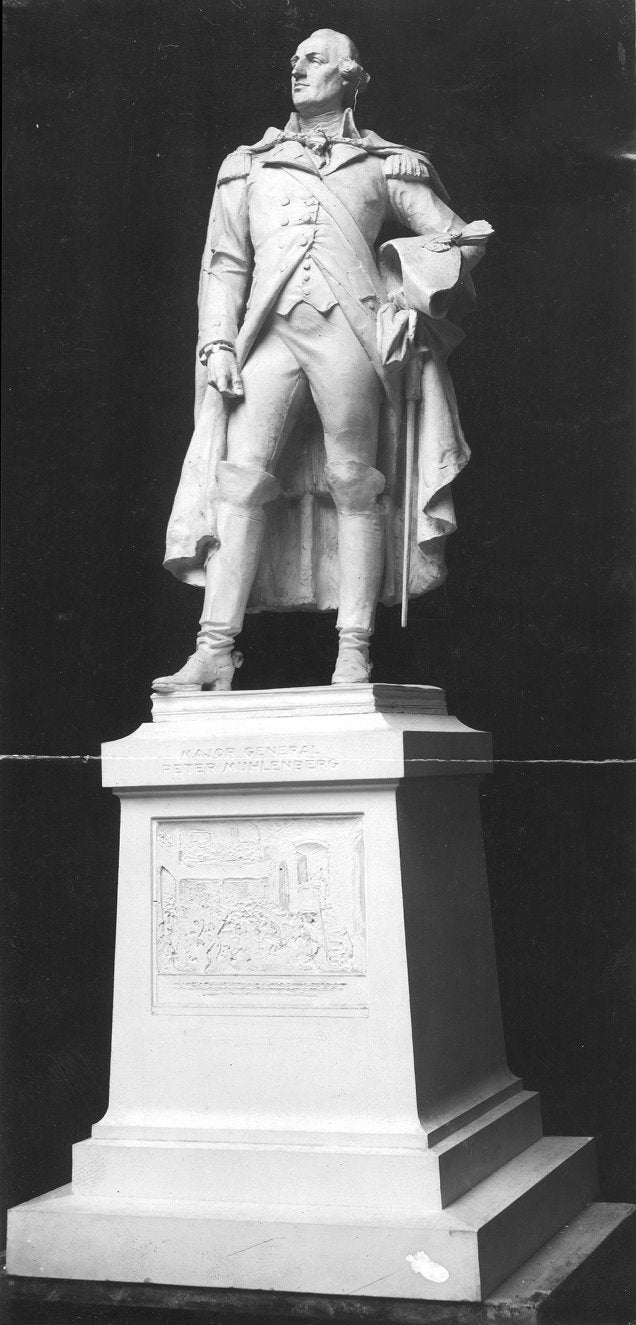John Peter Gabriel Muhlenberg was born in Montgomery County, Pennsylvania, the son of Rev. Henry M. Muhlenberg and Mary Weiser, and a brother of Frederick Augustus Conrad Muhlenberg. A member of Penn’s Class of 1763, he left the College before graduation and traveled to Europe with his brothers to study at the University of Halle. As a boy and a young man, however, John Peter enjoyed fishing and hunting more than studying and aspired to join the military. His mentors in Halle recommended that he be trained not in the ministry as his father had hoped, but in commerce. Thus John Peter came to be apprenticed to a merchant in Lubeck. After enduring three years with this man, a grocer who exploited John Peter’s labor, young Muhlenberg ran away to enlist in the Royal American Regiment of Foot in the British army. He returned to Philadelphia while a secretary to one of the officers, and received an honorable discharge in 1767.
Finally turning his attention to the study of theology, John Peter Muhlenberg soon won praise as a preacher in Swedish and German Lutheran congregations near Philadelphia. After he was licensed as a Lutheran minister in 1769, he at first assisted his father with congregations in New Jersey. The following year he married Anna Barbara “Hannah” Meyer, daughter of a potter. Next he was called to a church in Woodstock, in Virginia’s Shenandoah Valley, settled mostly by Pennsylvania Lutherans. Since Anglicanism was the established state church in Virginia, Muhlenberg traveled to London to receive ordination as an Anglican clergyman. He remained in Woodstock from 1772 to 1775.
During the early years of the Revolution, while Muhlenberg was still in Virginia, he became a follower of patriot Patrick Henry. His contributions to the revolutionary cause included service as the chair of the Committee of Safety in Virginia’s House of Burgesses (1775) and as a member of Virginia’s provincial convention in 1776. From 1776 to 1783, he also served in the Continental Army, as colonel, brigadier-general, and finally as a major-general. As he gathered his recruits and said farewell to his Woodstock congregation, Reverend Muhlenberg is said to have thrown off his clerical garb to reveal his military uniform, proclaiming “There is a time to pray and a time to fight, and that time has now come!” Muhlenberg took part in the fighting at Charleston, Brandywine, Stony Point, and Yorktown, as well as in the winter at Valley Forge.
After the war, Muhlenberg did not feel he could return to being a parson after having been a soldier. In 1784 he surveyed military bounty lands assigned to Virginia veterans, traveling as far as Louisville; but then he returned to his native Montgomery County, Pennsylvania. Later in 1784 his German neighbors elected him as Montgomery County’s representative to Pennsylvania’s Supreme Executive Council, the state’s governing body under its first constitution. At the end of his three-year term, Muhlenberg served as vice president of this body (the equivalent of lieutenant-governor). It was in this capacity that he became an ex-officio member of the board of trustees of the University of the State of Pennsylvania (now the University of Pennsylvania).
Shortly thereafter, Muhlenberg, as an anti-Federalist, was elected a Pennsylvania representative to the U.S. Congress, serving from 1789 to 1795 and again from 1799 to 1801. He was considered a key figure in the Democrat-Republican party of Pennsylvania, managing Thomas McKean‘s successful campaign for governor and helping to elect Thomas Jefferson as U.S. president. In 1801 he was elected to the U.S. Senate, but before taking his seat, he resigned to accept the lucrative position of supervisor of U.S. customs in the Pennsylvania District. In 1803 he became collector of customs of the Port of Philadelphia. He remained active as a Lutheran layman until his death in 1807 at his suburban home at Gray’s Ferry on the Schuylkill River.

